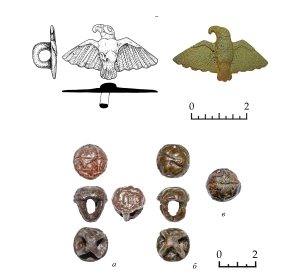 Vladimir E. Maslov*, Alexandr N. Gey**, Marina V. Andreeva***
Vladimir E. Maslov*, Alexandr N. Gey**, Marina V. Andreeva***
Institute of Archaeology RAS, Moscow, Russia
*E-mail: maslovlad@mail.ru
**E-mail: donkuban@mail.ru
***E-mail: amvlad11@yandex.ru
Keywords: North Caucasus, Adygea, Scythians, horse bridle, horse harness, “animal style”.
In 2011, the North Caucasian expedition of the Institute of Archaeology RAS in the Republic of Adygea excavated three mounds at the Dysh IV cemetery of the Scythian period. The main burials of the mounds, robbed in antiquity, contained burials of horses. Preserved items of harness and bridles of the latter made it possible to date mound 3 to the first third, and mound 2 to the second half of the 7th century BC. The analogies to the objects of the bridle from mound 1 presented in this paper suggest dating this complex within the first half – middle of the 5th century BC. The set under consideration contains objects related to both the Western and Eastern circles of the nomadic cultures, the samples of the “animal style” reveal Achaemenid and Greek features. Such a vivid cultural syncretism is possibly associated with the special cult significance of the Dysh cemetery for the newcomer mobile military groups, which was relevant for at least two centuries.
DOI: 10.31857/S086960630015272-8







